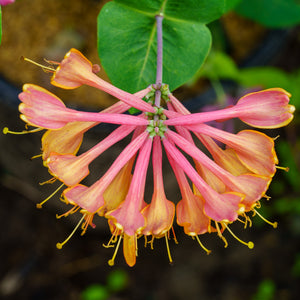The Honeysuckle Guide
Honeysuckle (genus Lonicera) is a diverse group of vines and shrubs known for their sweetly scented flowers, nectar-rich blooms, and value to pollinators. From twining vines that climb arbors and fences to compact shrubs for groundcover or hedging, honeysuckle adds beauty, fragrance, and functionality to the landscape. With both native and non-native species in cultivation, careful selection is important to ensure you choose a variety that enhances rather than overwhelms your garden.
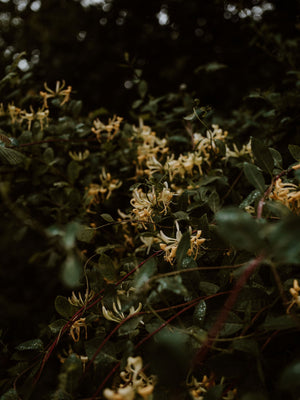
About
The Lonicera genus includes over 180 species and dozens of cultivated varieties. It can be broadly divided into two types: climbing vines and bush-type shrubs.
Vining honeysuckles are the most familiar, with trumpet-shaped flowers that attract hummingbirds, butterflies, and bees. Native selections like Lonicera sempervirens (‘Major Wheeler’, ‘John Clayton’, ‘Alabama Crimson’) are non-invasive and long-blooming, making them ideal for wildlife gardens and fences. Hybrids such as Lonicera x brownii ‘Dropmore Scarlet’ and Lonicera x heckrottii ‘Gold Flame’ combine extended bloom time with vivid color and good garden manners.
Shrubby honeysuckles include species like Lonicera fragrantissima, grown for its intensely fragrant winter blooms, and Lonicera nitida (‘Thunderbolt’), used for low hedging and evergreen texture. However, some shrubby types like Lonicera tatarica and Lonicera japonica are considered invasive in parts of the U.S. due to their aggressive spread and impact on native ecosystems.
Newer cultivars like ‘Peaches and Cream’, ‘Candy Swirl’, and ‘Scentsation’ offer improved fragrance, controlled growth, and season-long appeal. Flower colors range from soft yellows and creams to fiery oranges, scarlets, and pinks.
Whether you're looking for a fragrant trellis climber, an evergreen screen, or a pollinator magnet, honeysuckle offers diverse forms and functions with minimal care requirements.
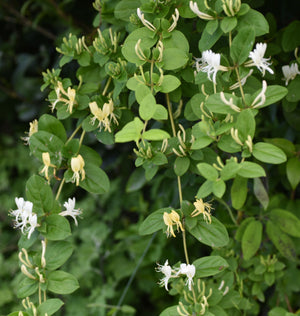
PLANTING
Proper siting and soil preparation will ensure your honeysuckle establishes quickly and performs reliably.
USDA Hardiness Zones:
- Lonicera sempervirens: Zones 4–9
- Lonicera x brownii, heckrottii, periclymenum: Zones 5–9
- Lonicera nitida (shrub types): Zones 6–9
- Lonicera fragrantissima: Zones 4–8
- Lonicera japonica: Zones 4–9 (invasive in some areas)
Soil: Tolerant of many soil types. Prefers well-drained soil enriched with organic matter. Will grow in sandy, loamy, or clay soil with proper drainage.
Sunlight: Full sun promotes the best flowering, though many varieties will tolerate partial shade, especially in hotter climates.
Watering: Provide regular watering during the establishment phase. Once established, most honeysuckles are drought-tolerant, though flowering may be reduced under prolonged dryness.
Spacing:
- Vining types: Plant 3–6 feet apart with support (fence, arbor, trellis)
- Shrub types: Space 3–5 feet apart depending on growth habit
Planting Time: Spring or fall is ideal. In warmer zones, fall planting allows roots to establish before the summer heat.
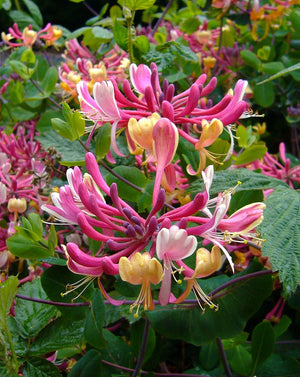
CARE
Honeysuckle is generally low-maintenance, but regular pruning and watering will encourage dense growth and extended blooming.
Watering: Water deeply and regularly in the first year. After establishment, most varieties only need supplemental water during drought.
Fertilizing: Apply a balanced fertilizer in early spring to encourage healthy growth and flower development. Avoid excessive nitrogen, which can reduce flowering.
Pruning: Prune vining honeysuckle after blooming to shape and control size. Shrubby types can be pruned in late winter or early spring before new growth. Rejuvenation pruning every few years helps maintain vigor.
Pests & Diseases: Aphids and powdery mildew are occasional problems, especially in overly humid or crowded sites. Good airflow and pruning help minimize issues.
Mulching: Mulch 2–3 inches deep around the base to conserve moisture and suppress weeds. Keep mulch a few inches away from stems to avoid rot.
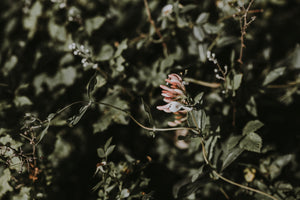
HOW TO USE
Honeysuckle offers an abundance of landscape uses—from vertical accents and fragrant entryways to pollinator gardens and informal hedges. Its adaptability, long bloom period, and wildlife value make it a reliable and impactful addition to gardens of all sizes.
Focal Point: Flowering honeysuckle vines like ‘Major Wheeler’, ‘Gold Flame’, and ‘Scentsation’ serve beautifully as focal points on arbors, obelisks, or trellises. Their vibrant blooms and climbing habit draw attention while creating vertical movement in the garden.
Vertical Screens and Fences: Use vining honeysuckles to cover chain-link fences, screen views, or soften hard surfaces. These vines are well-behaved alternatives to more aggressive climbers and can provide season-long coverage with vivid color.
Pollinator and Wildlife Gardens: Honeysuckle is a magnet for hummingbirds, butterflies, and bees. Combine it with other pollinator favorites like monarda, echinacea, and salvia for a dynamic, nectar-rich planting.
Cottage and Informal Gardens: Integrate vining honeysuckle with climbing roses, clematis, or perennial borders for a romantic, layered look. The soft fragrance and gentle climbing habit complement traditional and nostalgic designs.
Groundcovers and Banks: Some shrubby or low-spreading varieties like Lonicera nitida and Lonicera japonica can be used to cover slopes or large areas quickly. Use caution with invasive types—select non-invasive cultivars for managed spaces.
Fragrant Entrances and Pathways: Place fragrant varieties like ‘Scentsation’ or Lonicera fragrantissima near porches, patios, or walkways where their scent can be fully appreciated. These work well trained onto arches or pergolas near sitting areas.
Container Gardening: Smaller honeysuckle varieties or young vines can be grown in large containers with support. Ideal for patios or balconies where fragrance and vertical interest are desired without planting in-ground.
Companion Planting: Pair honeysuckle with ornamental grasses, clematis, shrub roses, or hardy perennials like coreopsis and nepeta to create layered, wildlife-friendly plantings. Honeysuckle's airy structure blends well without overwhelming companions.
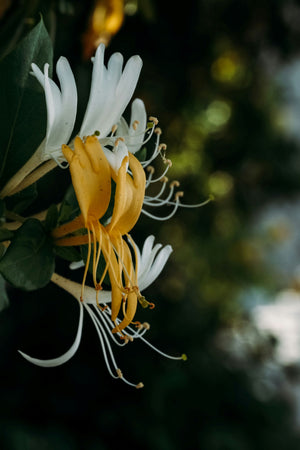
Common Questions
Can you eat honeysuckle? Some honeysuckle species have edible nectar in their flowers, but many berries are mildly toxic to humans. Only consume varieties specifically identified as safe, and avoid eating berries or large quantities of any part without confirmation.
Is honeysuckle invasive? Yes—some species, particularly Lonicera japonica and Lonicera tatarica, are invasive in parts of the U.S. and can outcompete native plants. Always choose non-invasive or native cultivars like Lonicera sempervirens for responsible planting.
What does honeysuckle look like? Vining honeysuckle has woody stems and produces tubular or trumpet-shaped flowers in colors like red, yellow, orange, and pink. Shrubby types may have small, glossy leaves and arching branches. Many varieties produce red or black berries in late summer.
How to grow honeysuckle? Plant in full sun to partial shade in well-drained soil. Provide support for climbing types. Water regularly while establishing, fertilize lightly in spring, and prune to shape after flowering.
How to propagate honeysuckle? Honeysuckle can be propagated from softwood or semi-hardwood cuttings in spring or early summer. Many species also layer easily—where a stem touches the ground, it may root and form a new plant.
Is honeysuckle poisonous to dogs or cats? Most honeysuckle species are mildly toxic to pets if ingested, potentially causing vomiting or diarrhea. Keep pets from chewing stems, leaves, or berries, especially from invasive or shrubby types.
Do deer eat honeysuckle? Yes, deer will browse honeysuckle, particularly tender new growth on shrubs. Vining types may be less affected, but protection may be needed in high-pressure areas.
Do rabbits eat honeysuckle? Rabbits may feed on the bark and young shoots, especially in winter. Protect young plants with fencing or repellents where rabbit activity is common.
What does honeysuckle smell like? Many honeysuckle varieties have a sweet, jasmine-like fragrance that intensifies in the evening. Some, like Lonicera fragrantissima, are prized specifically for their powerful winter or early-spring scent.
Conclusion
Honeysuckle offers a unique combination of fragrance, color, wildlife support, and versatility in the landscape. With forms ranging from twining vines to structured shrubs, and with native and non-invasive selections readily available, it can be tailored to fit nearly any design need. Whether you're creating a pollinator corridor, cloaking a garden fence, or adding a fragrant focal point, honeysuckle delivers long-lasting beauty with minimal fuss.
The Honeysuckle Collection
Sold Out
Sold Out
Sold Out
Sold Out
Sold Out





